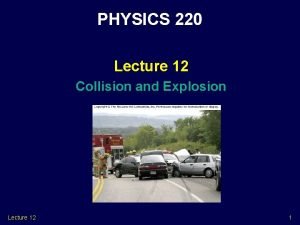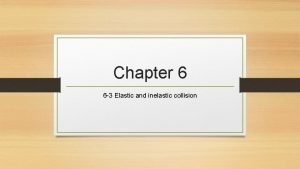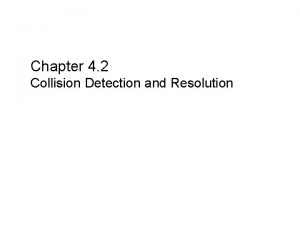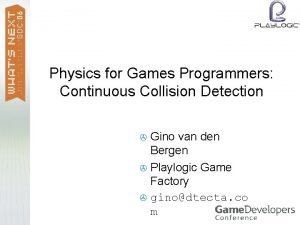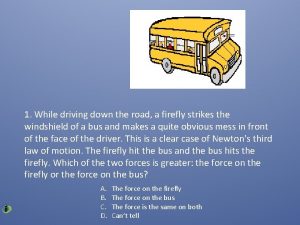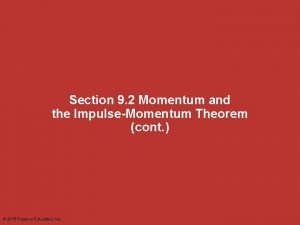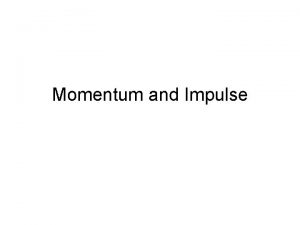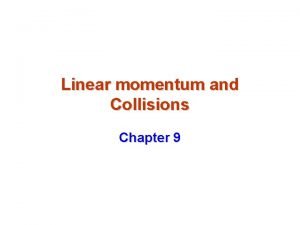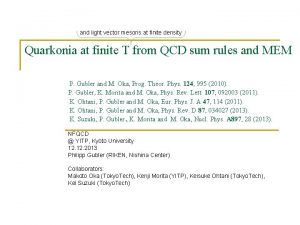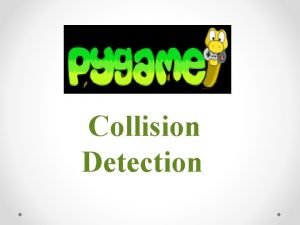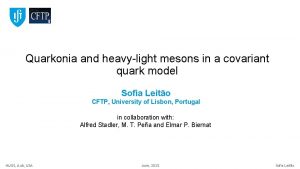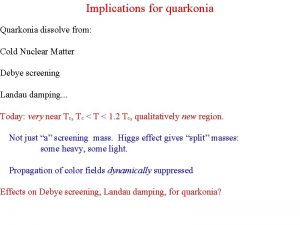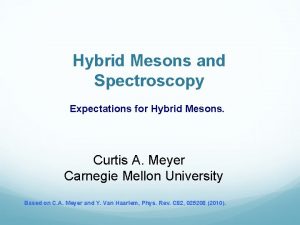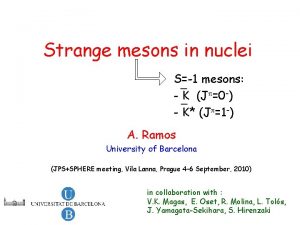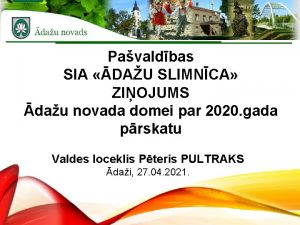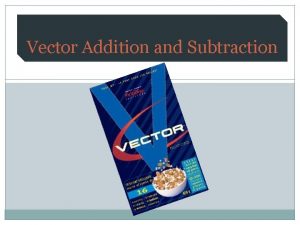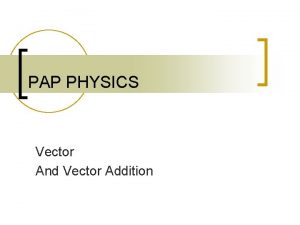Quarkonia and vector mesons in dAu collision at













- Slides: 13

Quarkonia and vector mesons in d+Au collision at forward rapidity in PHENIX Kwangbok Lee Korea University for PHENIX collaboration Kwangbok Lee 21 April DIS 2010, Florence, Italy 1

MotivationⅠ- Quarkonia in A+A state J/y cc U 1 S U 2 S U 3 S mass [Ge. V] 3. 10 3. 53 9. 46 10. 02 10. 36 DE [Ge. V] 0. 64 0. 20 1. 10 0. 54 0. 20 radius [fm] 0. 25 0. 36 0. 14 0. 28 0. 39 - Each quarkonium has different binding radius. hep-ph/0609197 v 1 H. Satz - Binding of a pair is subject to color screening in QGP. - Melting temperatures depend on their binding radius. - Temperature of QGP can be estimated or another models like regeneration can be tested. Kwangbok Lee ar. Xiv: 0911. 4806 21 April DIS 2010, Florence, Italy 2

RGPb MotivationⅡ- Quarkonia in d+A Q 2 = 1. 69 Ge. V 2 owing d a h s i t an n. DS EKS 98 Color Glass Condensate(CGC)/Gluon saturation. EPS 09 EPS 08 g shadowin ar. Xiv: 0902. 4154 Gluon density in different x Kwangbok Lee - Shadowing model <- Gluon densities in nucleus with different parton distribution functions(PDF) HKN 07 low x 1. Cold nuclear matter effect high x - Nuclear absorption (Now we are comparing shadowing models to J/y signal) - Initial state parton energy loss - Cronin effect 2. Essential information to understand QGP. 21 April DIS 2010, Florence, Italy 3

PHENIX Muon Arm South North Au + - <y> ~ -1. 7, x 2 ~ 0. 11 <y> ~ 1. 7, x 2 ~ 0. 0035 Gold going direction deuteron going direction thought to be in shadowing region North South d The average value of the momentum fraction x 2 in the gold nucleus vs. rapidity for √s. NN = 200 Ge. V Kwangbok Lee 21 April DIS 2010, Florence, Italy South North 4

Nuclear modification factors Ncoll pp d. Au (all centralities) d. Au (0 -20%) d. Au (60 -88%) 1 7. 6 ± 0. 4 15. 1 ± 1. 0 3. 2 ± 0. 2 Ncoll : number of binary collisions, 1 in p+p collision. If there is no nuclear matter effect, Rd. Au = Rcp = 1 If there is suppression, Rd. Au , Rcp < 1 Kwangbok Lee 21 April DIS 2010, Florence, Italy 5

J/y Rd. Au Run 2003 d. Au/Run 2005 pp, PRC 79, 059901(E) (2009) ar. Xiv: 0903. 4845(Erratum) Shadowing model comparison to Rd. Au values with EKS PDF and fixed breakup cross sections Published Rd. Au vs. rapidity result Kwangbok Lee With NDSG and fixed breakup cross sections PDF EKS(mb) NDSG(mb) breakup 2. 8 +2. 3 -2. 1 21 April DIS 2010, Florence, Italy 2. 6 +2. 2 -2. 6 6

J/y Rcp EKS σ = 0 mb σ = 4 mb PHENIX PRELIMINARY • Preliminary result with 2008 d+Au data which has ~30 times statistics than 2003 d+Au data. • Can’t fit the data with fixed breakup cross sections. NDSG σ = 0 mb σ = 4 mb PHENIX PRELIMINARY • Need to understand the suppression of shadowing region. Rcp vs. rapidity Kwangbok Lee 21 April DIS 2010, Florence, Italy 7

High mass distribution p+p d+Au Gold(Au) going, y<0 Physical background of Drell Yan, Kwangbok Lee Deuteron(d) going, y>0 and is estimated (pythia) 21 April DIS 2010, Florence, Italy 8

Upsilon cross sections BR*dσ/dy = 28. 2± 9. 4(stat. )± 4. 8(syst. )pb, y [-2. 2, -1. 2] BR*dσ/dy = 9. 6± 2. 1(stat. )± 1. 5(syst. )nb, y [-2. 2, -1. 2] BR*dσ/dy = 31. 1± 8. 7(stat. )± 6. 2(syst. )pb, y [1. 2, 2. 2] BR*dσ/dy = 6. 7± 1. 7(stat. )± 1. 5(syst. )nb, y [1. 2, 2. 2] • pp cross section is reference to comparison to d+Au collision. • pp cross section vs. rapidity is following the shape of Color Evaporation Model-CTEQ 6 M(PDF)(scaled down by ~2). • Cross section vs. rapidity of d+Au collision is asymmetric. Kwangbok Lee 21 April DIS 2010, Florence, Italy 9

Upsilon Rd. Au = 0. 84± 0. 34(stat. )± 0. 20(sys. ), y [-2. 2, -1. 2] Rd. Au = 0. 53± 0. 20(stat. )± 0. 16(sys. ), y [1. 2, 2. 2] • First Upsilon Rd. Au measurement at forward rapidity. • Showing suppression at small x region. • Waiting for theoretical comparison. Kwangbok Lee 21 April DIS 2010, Florence, Italy 10

Light Vector Mesons Rcp Gold(Au) going, y<0 Deuteron(d) going, y>0 • First nuclear modification factor measurement for low mass vector mesons in forward rapidity. • Significant suppression at deuteron going direction. • Stronger suppression for r/w than f and J/Y. Kwangbok Lee 21 April DIS 2010, Florence, Italy 11

Prospect for cc MPC 3. 1<|y|<3. 8 cc is a very important particle to calculate the actual feed-down contributions to J/y, Muon Arm to decouple the cold nuclear matter 1. 2<|y|<2. 2 effect. Foreground event Scaled mixed event Signal(Foreground – Mixed) Signal fitting with Gaussian and polynomial 2008 d. Au North arm Kwangbok Lee 21 April DIS 2010, Florence, Italy 12

Summary • Nuclear modification factors of Upsilon, J/y and light vector mesons are shown. • They show suppression at low x region but, not clearly understood yet. • Recent J/y Rcp result is not explained well with shadowing model and fixed breakup cross sections. • New Upsilon Rd. Au shows suppression in low x region and need to have theoretical comparison. • Low mass vector meson need to understand its production mechanisms. feed down to J/y measurement is underway and important to decouple the cold nuclear matter effect and QGP state. • In future, PHENIX FVTX/VTX upgrade will reduce more background and make the y’ and even Drell-Yan measurement possible. • Kwangbok Lee 21 April DIS 2010, Florence, Italy 13
 111011-100100
111011-100100 Properties of vector
Properties of vector Fsica
Fsica Resolution of vectors
Resolution of vectors What is position vector
What is position vector Explosion collision physics
Explosion collision physics Types of collision
Types of collision Collision detection and resolution
Collision detection and resolution Collide and slide algorithm
Collide and slide algorithm While driving down the road
While driving down the road A mosquito and a truck have a head on collision
A mosquito and a truck have a head on collision Momentum impulse and collision
Momentum impulse and collision Collisions equation
Collisions equation Dấu hiệu chevassu
Dấu hiệu chevassu





